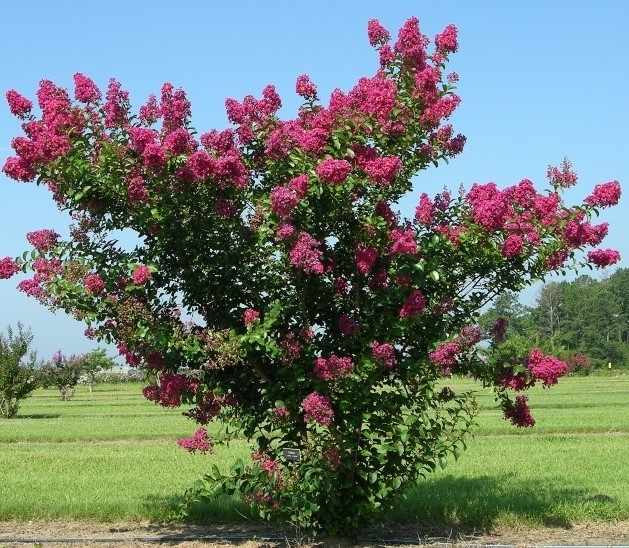
by Gary Knox | Jul 29, 2013
Crapemyrtle flowering has been spectacular this year!
While most other garden plants droop from summer’s heat, humidity and heavy rains, crapemyrtle thrives and puts on an outstanding show of flowers all summer and fall. Thanks to modern breeders, there are all sizes of improved hybrid crapemyrtles with flower colors of lavender, purple, white, pink, or red.
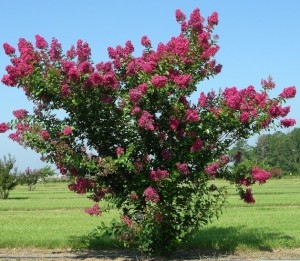
Crapemyrtle Cultivar: ‘Tonto’
Image Credit: Gary Knox
Just say “No” to Pruning
- Crapemyrtle varieties come in tree-size, patio tree and shrub categories.
-
Tree-size crapemyrtles grow 25 ft. tall and are ideal as flowering trees. Patio tree-form plants (up to 12 ft.) are beautiful as small, flowering specimen plants near patios, walkways, and entrances. Shrub forms (up to 6 ft.) make excellent accents in a shrub border and smaller types are effective as large groundcovers or container plants.
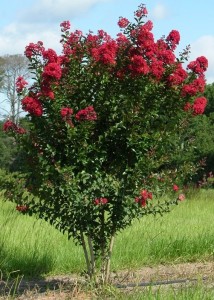
Crapemyrtle Cultivar: ‘Red Rocket’
Image Credit: Gary Knox
- Make sure you buy the right size crapemyrtle for your home. Don’t make the mistake of planting a tree-size crapemyrtle in an area too small for its ultimate size, or you’ll find yourself pruning it hard – and often – to keep it from out-growing its place.
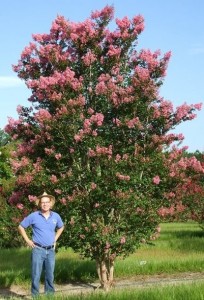
Crapemyrtle Cultivar: ‘Sioux’
Image Credit: Gary Knox
Recommended Varieties
- Some of the best tree-size (25 ft.) types are Natchez (white), Red Rocket® (red), Sioux (pink) and Apalachee (lavender). Superior patio tree crapemyrtles (12 ft.) are Acoma (white), Cheyenne (true red), Tonto (fuchsia red), Hopi (pink) and Catawba (purple). Smaller shrub (6 ft.) crapemyrtles are hard to find, but Cherry Dazzle® is a nice mounding red and Pixie White and New Orleans (purple) are good selections.
Planting and Garden Care
- When it comes to planting, crapemyrtle is very tolerant and forgiving with three exceptions. First, crapemyrtle needs sun to flower freely, so plant it in a site receiving at least six hours of direct sunlight each day. Secondly, crapemyrtle will not grow in wet soils. Finally, never plant crapemyrtle too deep — if you do so, it will punish you by not flowering for years and years. Planting too deep literally smothers the roots, requiring the crapemyrtle to regenerate a new root system in the soil above.
- Crapemyrtle is very drought tolerant and almost seems to thrive on neglect. On the other hand, regular watering and fertilizer will help crapemyrtle grow faster and bigger.
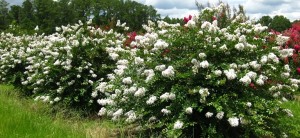
Crapemyrtle Cultivar: ‘Acoma’
Image Credit: Gary Knox
More Beauty on the Way!
- Breeders are continuing to improve and introduce new crapemyrtles. Many new varieties were released in the last couple years. In particular, watch for new types with purple-burgundy leaf color all summer long! Time will tell which new ones grow best in Northwest Florida. Stay tuned as the world of crapemyrtle continues to evolve and improve!
*Gary Knox is Professor of Environmental Horticulture with the University of Florida. He is stationed at the North Florida Research and Education Center in Quincy, where he evaluates more than 100 cultivars of crapemyrtle.
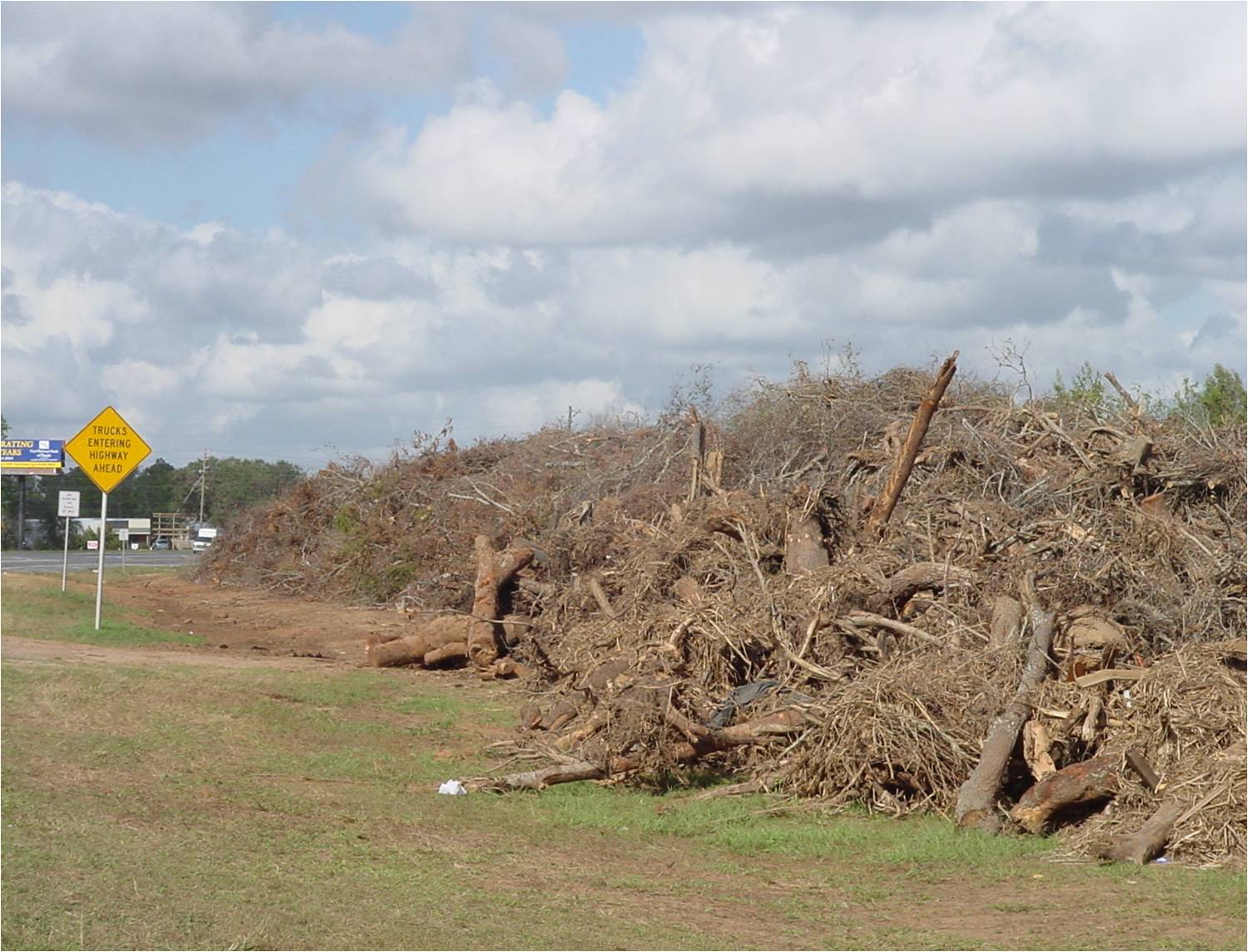
by Carrie Stevenson | Jul 29, 2013
Few things move a local homeowner into action faster than a big storm moving into the Gulf of Mexico. After filling up at gas stations and running out to home improvement stores, many start trimming limbs and removing trees.
The destructive tornadoes in the Midwest this spring may cause anxiety about having mature trees in a yard. It is true that falling trees and limbs can cause damage to a home and property. However, it is wise to look closely at a landscape before making a permanent decision. It’s also important to do this before the stress of a looming storm is at hand. Trees are very important for providing shade (i.e. energy savings), wildlife habitat, storm-water management, and maintaining property values.
University of Florida / IFAS researchers have done long-term studies on the effects of wind on trees and landscapes, and several important lessons stand out. Keep in mind that reducing storm damage often starts at the landscape design / planning stage!
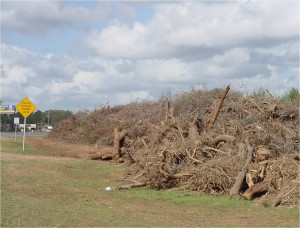
After a hurricane, piles of vegetative debris are common sights. Photo credit: Carrie Stevenson
Below are several tips for protecting your home and landscape in case of a storm.
- Plant high-quality trees with single trunks and strong branches. Branch attachment angles can affect whether a large branch will split from a tree. Branches angling straighter out from a tree (wide angles) are stronger than those pointing almost directly up (tight angles).
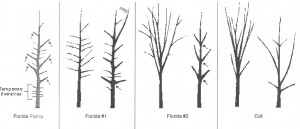
“Florida fancy” is the best quality of tree, with quality decreasing to “cull” level. Notice the difference in branch angles and direction between each group. Figure courtesy FDACS, Division of Plant Industry
- Trees that have had regular pruning are less likely to fail than neglected trees. The UF horticulture website has detailed information on correct pruning, or you can contact your County Extension Agent for tips.
- Post-hurricane studies in North Florida show that Live Oak, Southern magnolia, Sabal Palm, and Bald Cypress stand up well compared to other trees during hurricanes. Pecan, Water and Laurel Oak, Carolina Cherry Laurel and Sand Pine were among the least wind resistant. UF has a list of trees and their hurricane endurance based on a study conducted after the 2004 hurricane season.
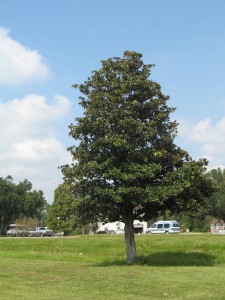
The classic Southern magnolia tree earns high marks in wind resistance. Photo credit: Carrie Stevenson
- Plant a variety of species, ages and layers of trees to maintain diversity in the yard and neighborhood.- Trees with decayed trunks are very dangerous in winds. Disease causing decay can come up from the roots or enter through improper pruning cuts. Remove hazard trees before the wind does. Have a certified arborist inspect trees for signs of disease and decay. They are trained to provide advice on tree health.
- Watch pines carefully. Sometimes there is hidden damage and the tree declines over time. Look for signs of stress or poor health, such as unusual dark stains or small holes on trunks, dropping leaves, or piles of sawdust at the tree’s base. Check closely for insects. Weakened pines may be more susceptible to beetles and diseases. Long-leaf pines often survive storms in our area better than other species.
- Trees in a group (at least five) blow down less frequently than single trees.
- Trees should always be given plenty of room for roots to grow. Roots absorb nutrients, but they are also the anchors for the tree. If large trees are planted without enough space for roots to grow out in all directions, there is a likelihood that the tree may fall during high winds.
- Construction activities within about 20 feet from the trunk of existing trees can cause the tree to blow over more than 10 years later.
- When a tree is removed or dies, plant a new one in its place.
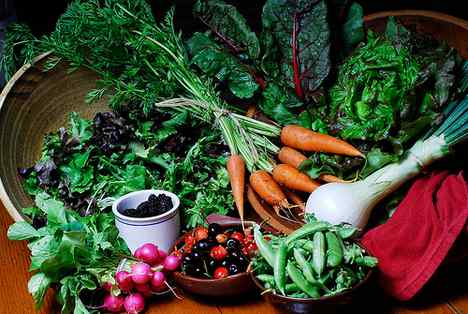
by Matthew Orwat | Jul 29, 2013
Announcing… an exciting local workshop coordinated and hosted by the FAMU State-Wide Small Farm Programs in collaboration with the Ekanlaunee Seed Exchange, Leon County Extension, and local small farmers
The 2013 Seed Workshop: Saving Seed, Saving Farms, Enabling Sustainability
Sunday, August 11, 2013 from 11:00 AM to 6:00 PM (EDT)
FAMU VITICULTURE & SMALL FRUIT RESEARCH CENTER
6505 Mahan Drive
Tallahassee, FL 32308
Sponsored by:

The 2013 Seed Workshop: Information Directly from FAMU
After 10 years of trying to work it out, FAMU is thrilled to be bringing the internationally-known US seed saving pioneer Ira Wallace of Southern Exposure Seed Exchange to Tallahassee to facilitate this capacity building workshop.
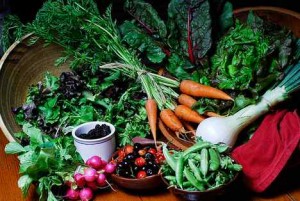
Image Credit: FAMU
The workshop will cover all kinds of seeds grown in the southeast region including greens, lettuce, eggplant, peppers, okra, peas, corn, cucumbers, melons, squash, herbs, beets, carrots, onions, parsnips, cabbage, broccoli, Brussels sprouts, kohlrabi, etc.
During FAMU’s hands-on workshop with Ira on “The Seed” you will learn:
What Is Seed?
Why Seed Saving Matters
Getting Started with Seed Saving
Fundamentals of Good Seed Saving (crossers and selfers, how to promote good seed set, how to maintain your crop’s genetics, isolation, population size and roguing, etc.)
Controlling Pests and Diseases
Dry and Wet Fermentation Seed Processing
Simple Seed Cleaning Techniques
Storage Techniques
The Business of Growing Seed for Farm and Sale
If you have seed you are trying to save that’s not listed, let us know and we will try to cover it too.
Register by credit card or check at: http://theseedworkshop2013.eventbrite.com/
Registration includes an organic lunch. To reserve a lunch with your workshop seat, please register by 11:55 PM Wednesday 7 AUG. Late registrations will be accepted as space permits — through Eventbrite until 11:55 Friday 9 AUG, and at the door on Sunday 11 AUG — but lunch cannot be guaranteed.
For questions about the workshop or registration, contact: Dr Jennifer Taylor, FAMU StateWide Small Farm Programs/Cooperative Extension, at FAMU.Register@gmail.com
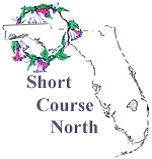
by Matthew Orwat | Jul 29, 2013
Short Course North 2013 “From Beaches to Woodlands”
 Date: August 8-9, 2013
Date: August 8-9, 2013- Daily Hours: 8 a.m.-4p.m.
- Sponsored by:
Friends of the Gardens of NW FL
Florida Federation of Garden Clubs, Inc.,
- University of Florida, IFAS
- For more info: Ttuttle1954@gmail.com
- Location: Santa Rosa County Extension Office 6263 Dogwood Drive, Milton, FL 32570
Topics of Study and hands-on activities will include:
- Snakes and Reptiles Scrub Habitat
- Gardening in Sandy Soil Coastal Concerns
- Florida’s Endangered Plant Advisory Council Long-leaf Pines
- Wildflower Research Invasive Plants and Exotics
- Using Native Plants in Designs Boondoggling
Come Learn, Come Buy, Come Win: Vendors, Plant/tool Sales, Auctions, Door Prizes, Raffle Baskets, Freebies!
by Matthew Orwat | Jul 28, 2013
Question of the Week. What is the name of this plant??? Please post your comments below. The answer will be revealed next week !
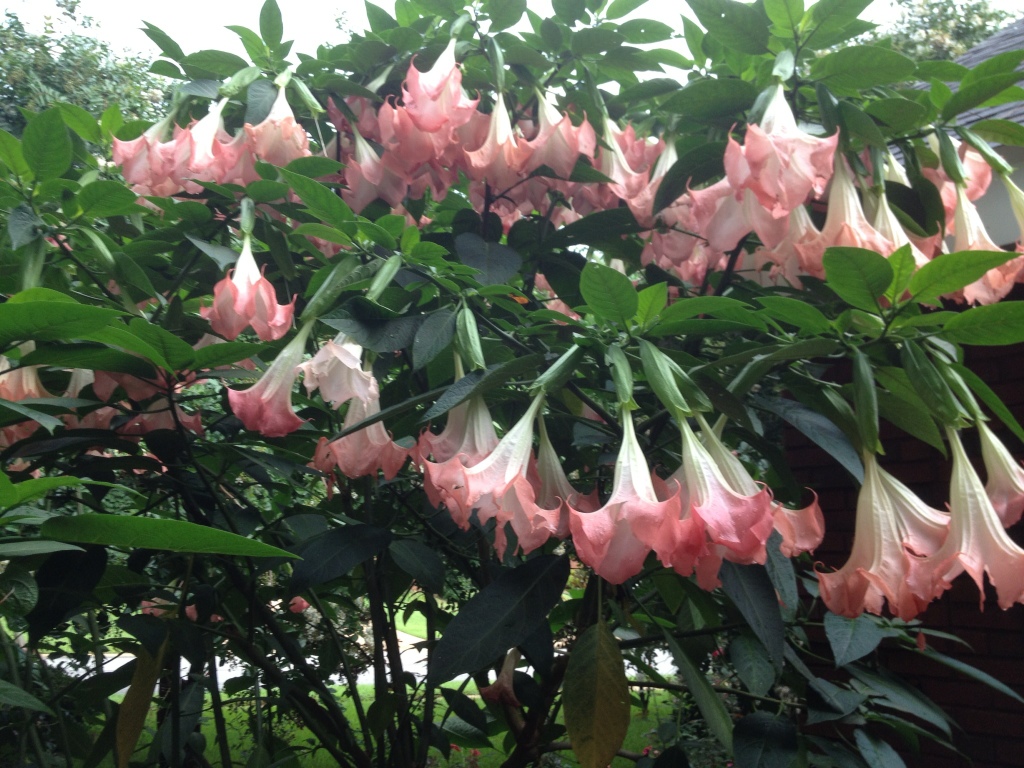
What it the name of this plant? Image Credit: Dr. Pete Vergot
The answer is Brugmansia spp.
Edward F. Gillman states in his publication:
“This small tree with large, 6- to 8-inch-long, simple leaves
makes a dramatic statement in any landscape. Reaching
perhaps to 15 feet tall, this densely foliated plant puts on a no
less than spectacular show when in full bloom in summer and
fall. Flowers hang from the stems and branches and drape the
plant with orange, white or yellow for a number of weeks.
Flowers can be up to 12 inches long.”
In Northwest Florida, this may die to the ground in the winter, and will need protection from extremely cold temperatures
It often will re-seed itself.














